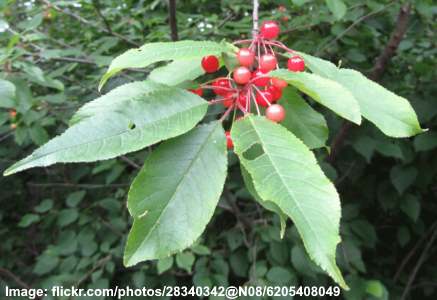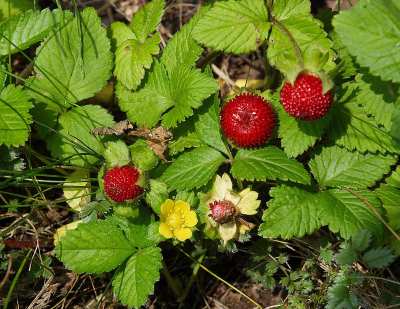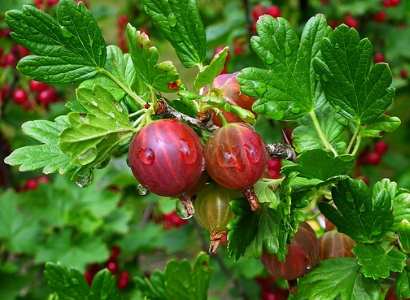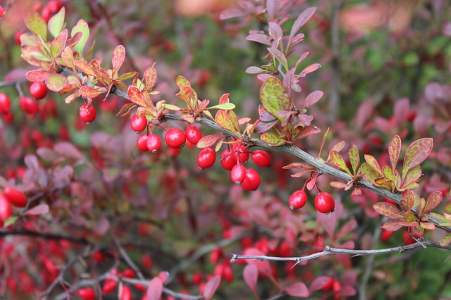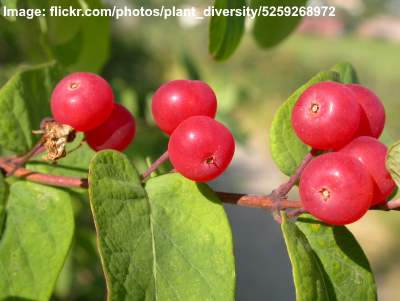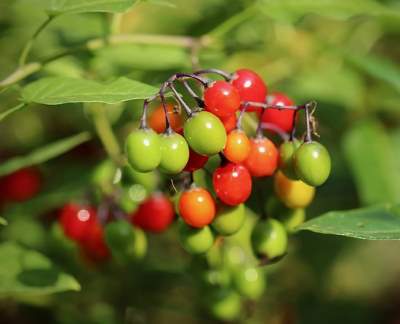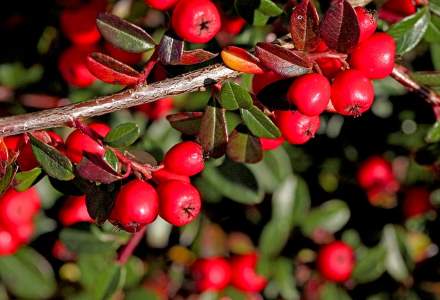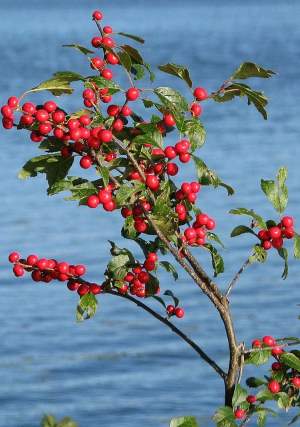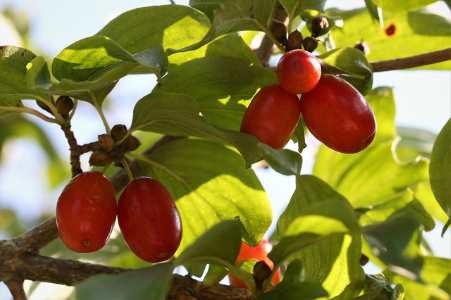Types of Shrubs With Red Berries: Identification Guide with Pictures and Names
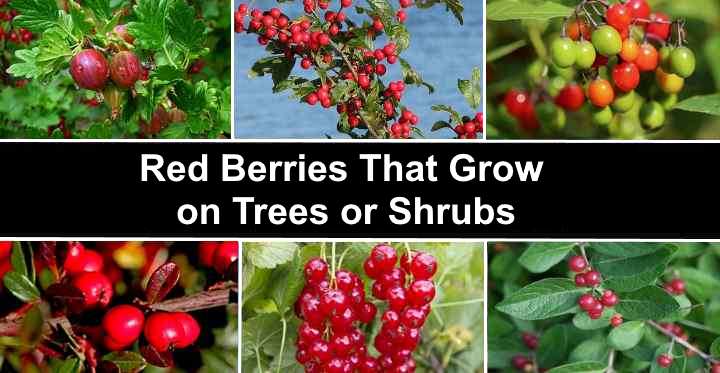
Red berries that grow on shrubs add a dash of color to any garden. Shrubs with edible red berries have the bonus of providing tasty, healthy fruits. Who can’t resist eating juicy red gooseberries or tart red currants? However not all red berries are edible, and it’s essential to distinguish between the ones that are good for you and poisonous berries.
There are many reasons to have bushes in your backyard that produce red berries. Very often, the scarlet-colored berries appear in winter when gardens and yards may lack color. The bright red colors contrasting with dark green foliage can help brighten up your yard.
Another reason to have edible red berries in your garden is that they are incredibly healthy. Apart from having a great taste, red berries that you can eat are packed full of antioxidants. You can eat them straight off the bush or use them in salads, desserts, or cereals.
You may also come across red berries while walking in woodlands, forests, or other open spaces. It’s important to remember that some types of red berries are extremely poisonous. So, you need to identify the exact species of berry before eating them. If you have any doubts, you should avoid eating red-colored berries that are unfamiliar.
In this article, you will learn about the many types of shrubs that grow red berries. Pictures, descriptions, and the scientific names of these types of fruits will help identify the bushes where fiery red-colored berries grow.
Identification of Red Berries
To identify the type of berry growing, you need to identify the tree or bush. To do this, you should take note of the shape of the leaves, size of the tree or shrub, and shape of the plant.
When you think of plants producing red berries, most people think of strawberries and raspberries. However, botanically speaking, these types of fruits are not true berries. Scientists classify these juicy summer fruits as aggregate accessory fruits rather than a kind of berry.
Bushes or Shrubs with Red Berries
There are many shrubs or large bushes with red berries that look amazing in any landscape.
For example, the cotoneaster has small glossy leaves, white flowers in spring and summer, and then brilliant red berries in the fall and winter. Holly shrubs are synonymous with Christmas with their glossy jaggy green leaves and inedible poisonous deep red berries. Although eating these types of red berries may not kill you, ingesting them can cause nausea, stomach cramps, and even seizures.
Shrubs such as red currants and red gooseberries both produce red berries that are delicious to eat.
Types of Shrubs With Red Berries (With Pictures and Identification Guide)
Let’s look in more detail at many kinds of shrubs or bushes that produce red berries.
Pin Cherries (Prunus pensylvanica)
Pin cherries are small edible red berries that grow on a large shrub, sometimes reaching the height of a small tree.
Also known as bird cherries, red cherries, or fire cherries, these vibrant red berries grow on a shrub that can range between 16 and 98 ft. (5 – 15 m) in height. The shrub can be identified by a round-topped crown, and its lanceolate leaves that grow alternately on long reddish thin stems.
Each of these small bright red cherries can reach a size of up to 0.31” (8 mm) in diameter and contains a single seed.
Pin cherries are commonly found along river banks and in parks.
Snake Berries (Potentilla indica or Duchesnea indica)
Although not classed as a true berry, snake berries produce red or white fruits that look like berries. Snake berry plants also have the common names of Indian strawberry, false strawberry, or mock strawberry.
It can be challenging to tell snake berries apart from true strawberries just by their leaves and growth habit. Visually, their foliage is similar with light green leaves that have serrated edges. The snake berries are similar in size to small strawberries but have a spiky look to them. Unlike true strawberries that are juicy and tasty, mock strawberries have little taste.
The National Institutes of Health says that snake berries from the Duchesnea species are not poisonous. (1)
However, because snake berries are a common name for a few other plants, some other species of berries may be toxic. For that reason, you should always check the scientific name when identifying plants. Later in the article, you can read about bittersweet nightshade – a plant with poisonous red berries, also called snake berries.
Red Gooseberry Bush (Ribes uva-crispa)
You may associate gooseberries with types of sour green berries, but some gooseberry shrubs produce red berries.
Gooseberry shrubs usually grow to about 5 ft. (1.5 m) high and have woody stems with sharp thorns. Leaves on the gooseberry bush are light green with 3 or 5 lobed leaves. The tart green or red berries have an oval shape with tiny hairs covering them.
As well as producing red or green berries, some species of gooseberries have white or yellow berries.
Due to their tartness, gooseberries are a great type of berry you can use in savory or sweet dishes. You can sweeten them and use them as a pie filling. Or, you can spice them up to make homemade gooseberry chutney.
Red Chokecherry (Aronia arbutifolia)
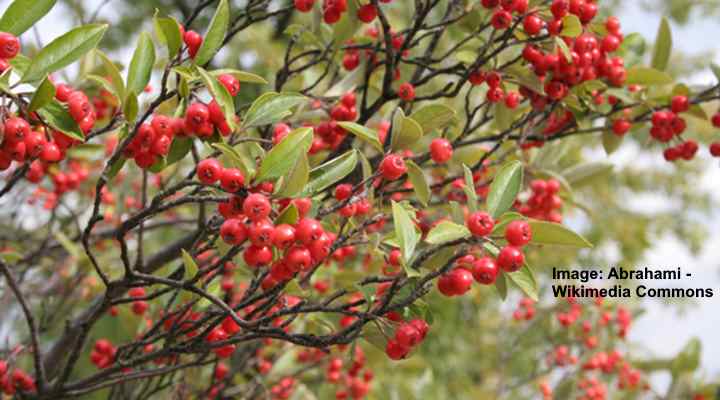
Red chokeberries grow on a bushes and have sour taste
Chokeberries are a species of deciduous shrub that have large red or black berries. Also called Aronia berries, these sour-tasting shrub berries really make your mouth pucker.
The most common type of chokeberry bush is the black chokeberry. However, the species Aronia arbutifolia is the species of shrub that produces red chokeberries.
Red chokecherry is a tall, multi-stemmed shrub with masses of red berry clusters covering bare branches in the fall and winter. This hardy decorative flowering shrub has clusters of showy white, four to five-petalled flowers blooming in late summer, glossy, dark green leaves, and clusters of attractive red berries. Although you can eat the fruits straight off the bush, they are too sharp and sour for most people to eat raw.
One of the attractive features of red chokecherry shrubs is their fall colors. The deep green leaves turn brilliant shades of red before dropping to the ground. The bright red leaves complement the abundant red berries on the shrub.
This slow-growing bushy shrub grows 5 to 10 ft. (1.5 – 3 m) tall and up to 5 ft. (1.5 m). This low-maintenance shrubby plant requires minimal pruning or care when growing in well-drained soils in USDA zones 4 to 9.
When planted in groups, red chokeberry shrubs make an excellent hedge or privacy barrier. Also, due to its tolerance for soggy ground, you can plant the shrub near streams or ponds.
Red chokeberry shrub should not be confused with chokecherry tree (Prunus virginiana) which is a small perennial tree or multi-stemmed shrub producing abundant dark red berry-like drupes that turn dark purple-black when mature.
Barberry (Berberis)
Barberry is a shrub that grows in most parts of the world and has small edible red berries on it. Some species of this flowering shrub are deciduous and some are evergreen.
This plant with red berries is identified by its long shoots that can grow up to 13 ft. (4 m) high. You will notice that the shoots have small oval green leaves that grow in clusters. After the yellow flowers appear, red oblong-shaped berries appear. These can be up to 0.39” (1 cm) long. You can eat the bright red berries straight off the plant, but they taste very sour.
Redcurrants (Ribes rubrum)
No list of the most popular red berries would be complete without mentioning redcurrants. Redcurrants are in the same family, Grossulariaceae, as gooseberries.
The redcurrant shrub has thin stems and large 5-lobed leaves. The most noticeable feature of the redcurrant plant is the large clusters of edible red berries hanging off the branches. These translucent red berry fruits are around 0.39” (1 cm) in diameter. There are so many currants on the bush that a single season can produce up to 9 lb. (4 kg) of tasty bright red berries.
What do redcurrants taste like? Many describe redcurrants having a tarter taste than black currants or white currants with hints of raspberry, gooseberry, and rhubarb.
Hobble Bush (Viburnum lantanoides)
Also called moosewood, witch-hobble, and the American wayfaring tree, this perennial type of shrub has red berries that turn black as they ripen.
The shrub is native to the eastern regions of North America, where it is found in forests, growing along river banks, and in swamps. The large bush has large oval leaves with serrated margins. These can grow to between 3.9” and 7.8” (10 – 20 cm) long. Clusters of showy flowers appear before the red edible fruit berries.
Many people describe the taste of hobble bush berries as sweet like raisins or dates. They are an ovoid shape, measure 0.6” (1.5 cm) long, and seemingly taste better after frost.
Tatarian Honeysuckle Bush (Lonicera tatarica)
Tatarian honeysuckle produces bright red berries that you should never eat. This bushy shrub is identified by its dull dark green oval leaves and large tubular pink to white flowers.
Like many species of shrubs in the honeysuckle family, the Tatarian honeysuckle is a large, oval-shaped flowering bush. It can grow to between 9 and 12 ft. with a large spread. It looks stunning when dark pink flowers cover the green foliage.
Because of its vigorous growth habit, many people consider this plant as an invasive species. Although the red berries look juicy and tempting, they are toxic to humans. Eating these berries by mistake can cause diarrhea, vomiting, and abdominal cramping.
Bittersweet Nightshade (Solanum dulcamara)
With a name like bittersweet nightshade, it is not surprising that you shouldn’t eat the red berries from this plant. Other names for this shrub include poisonberry, poisonflower, and bitter nightshade. Another common name is snakeberry, and it shouldn’t be confused with mock strawberries (also called snake berries).
Bittersweet is an herbaceous vine that is in the nightshade family, Solanaceae. This means that bittersweet plant is related to tomatoes, potatoes, and eggplants.
The red berries on bittersweet can look like tiny red tomatoes. Even though the red berries look soft and juicy, they are poisonous for humans and are dangerous for children.
Cotoneaster
The masses of dull red berries on cotoneaster plants may look attractive, but they are highly toxic and you should never consume them. Most species of cotoneasters in the genus are small to large shrubs growing between 1.6 and 16 ft. (0.5 – 5 m) tall.
The red berries on the leafy shrub look like clusters of cranberries. The leaves can be any shape from ovate to lanceolate and up to 6” (15 cm) long, depending on the species. Most species of cotoneaster shrubs have masses of poisonous red berries. However, berries can also be pink, scarlet-red, orange, or black.
Winterberry (Ilex verticillata)
Winterberry is a deciduous shrubby plant in the holly family that produces many inedible red berries. Although the berries have been used in traditional medicine, ingesting them can cause nausea and low blood pressure.
Winterberry shrubs have great ornamental value in landscaped gardens. They grow to between 3 and 16 ft. (1 – 5 m) tall and have glossy green leaves from spring to fall. The lance-shaped leaves have slightly serrated edges that are 3.5” (9 cm) long. As its name suggests, winterberry berries last throughout the winter. The leafless branches are adorned with clusters of scarlet-red berries.
These shrubs provide beautiful color in a winter garden.
Red Heavenly Bamboo Berries (Nandina Domestica)
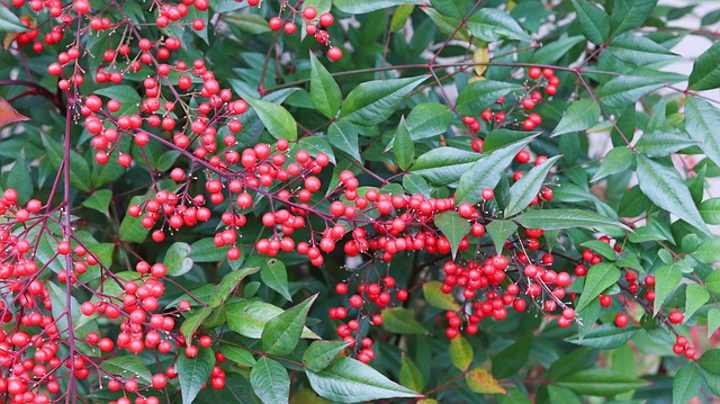
Nandina domestica (heavenly bamboo) shrub has poisonous red berries and summer green foliage before turning red in autumn
Nandina (Nandina domestica) is an evergreen, ornamental landscape shrub with upright growth, brightly colored leaves and crimson red berries that are poisonous. Nandina shrubs are adaptable to most conditions. They grow well in most types of soils, survive drought well, and are relatively pest and disease resistant.
Nandina bushes bloom in spring, and new leaves appear reddish-pink. Summer colors are green before the leaves turn red, and the red berries appear in fall and persist through winter.
Nandina thrives in USDA zones 6 to 9 and grows best in full sun or partial shade. It has medium growth and matures between 6 and 8 ft. (1.8 – 2.4 m) tall and up to 3 ft. (1 m) wide.
Nandina is considered invasive in many areas due to its suckering nature. However, if you want to grow nandina in your yard, you can choose from many nandina cultivars that don’t produce flowers and fruit, and therefore are better for growing in gardens.
Butcher’s Broom (Ruscus aculeatus)
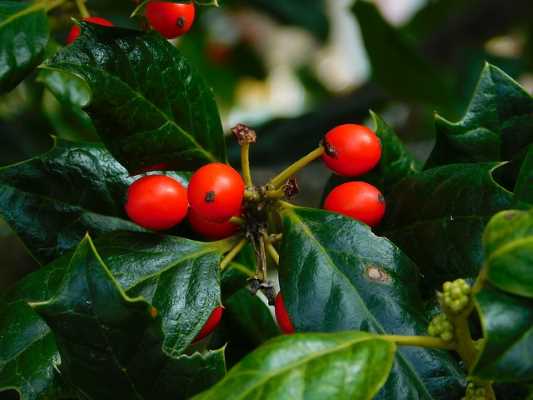
Butcher’s broom is an evergreen shrubs with red berries that are edible to birds but poisonous for humans
The red berries on an evergreen butcher’s broom shrub are identified as large round or oblong glossy red fruits that ripen in the late summer and fall. The attractive red fruits on the evergreen bush grow in small clusters. The berries emerge green before turning a bright red color in the summer.
Butcher’s broom berries measure 0.4” (10 mm) across.
Another identifying feature of butcher’s broom shrubs is the large, unusual spiny, thick leaf-like structures measuring 1.5” (38 mm) long. This growth characteristic is modified stems that look like leaves. The tough red berries grow among the stiff leaves.
Due to the evergreen foliage and abundant deep red to bright red berries, butcher’s broom is a common landscaping plant. The bushy shrub keeps its red and green colors throughout the winter.
High Bush Cranberry (Viburnum trilobum)
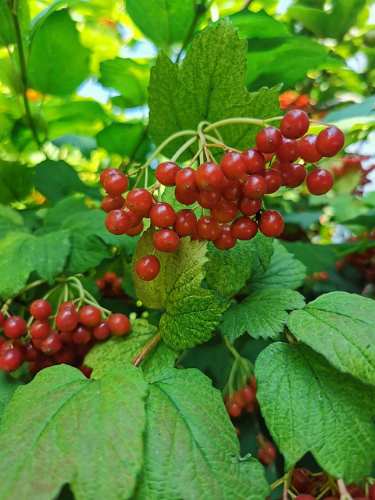
Highbush cranberry is a deciduous shrub with sour tasting small red berry-like fruit
The deciduous high bush cranberry shrub is a beautiful plant with clusters of tiny red glossy berry-like drupes. The tangy edible red berries have a sour taste, just like cranberries. The berries can be eaten fresh off the low-growing bush or used to create a sweet and sour sauce to serve with meat.
The high bush cranberry shrub has dense arching stems with reddish-brown bark and attractive leaves. Its red berry like fruit measure 0.6” (15 mm) long and 0.47” (12 mm) broad and brighten up fall and winter garden landscapes.
Other names for the high bush cranberry include cranberrybush viburnum, highbush cranberry, or American cranberry. Despite its name, the small shrub isn’t related to the cranberry (Vaccinium subg. Oxycoccus). Instead, the name cranberry comes from the resemblance of the shrub’s red fruits to cranberries. Like cranberries, the small bright red berries persist on the plant until early winter.
Its leaf shape is another recognizable feature of this viburnum plant. The foliage consists of maple-like leaves with a rounded bottom and serrated margins. The large high bush cranberry shrub comes to life in spring when clusters of pretty white flowers bloom. These are followed by bunches of shiny round pale red to bright red berries. In the fall, the shrub’s foliage turns a spectacular red color.
Linden Viburnum (Viburnum dilatatum)
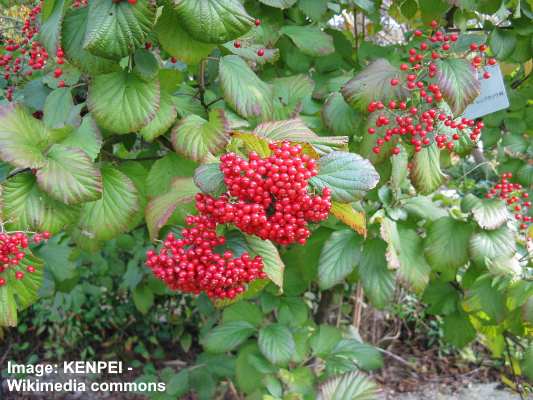
Linden viburnum shrub produces little red edible “berries” and is identified by it linden-like leaves
Linden viburnum is identified by its large clusters of tiny red “berries” with a smooth, shiny coating. The glossy red drupes provide plenty of color in the garden, contrasting with the large heart-shaped leaves. The linden viburnum is usually planted as an ornamental landscape plant for its beautiful white flowers and vibrant red berry clusters.
Also called linden arrowwood, this Viburnum species is a 10-foot (3 m) tall shrub with red berries measuring 0.3” (8 mm). Apart from its characteristic red berries, identifying features of the linden viburnum are its broadly ovate leaves with toothed margins, orangey-brown bark, and white flowers. In the fall, its dark green leaves turn to shades of red, burgundy, and bronze.
The common name of Viburnum dilatatum comes from the shrub’s foliage that is like leaves from the linden tree. To increase the number of bright red berries on the bush, plant a few shrubs together to create a flowering hedgerow.
Although it is planted throughout North America in residential gardens, some areas consider it invasive.
Raspberry (Rubus idaeus)

Raspberry bush produce red berry-like delicious fruit that can be eaten fresh from the shrub or cooked in deserts
The red raspberry is a sweet-tart red fruit that grows on a bush. The tasty red fruits are relatively small, measuring about 0.4” (1 cm) long. Red raspberries have a bumpy texture because they consist of tiny juicy fused capsules, each containing seed. Raspberry bushes are perennial plants that grow 5 to 8 ft. (1.5 – 2.5 m) tall.
Although commonly called a berry, raspberries are a type of aggregate fruit that contains several drupelets. These bright to dark red drupelets form a conical fruit. When picking raspberries from the bush, the core separates, revealing a hollow fruit. This habit is different between raspberries and other fruits in the genus Rubus—blackberries, dewberries, and brambles.
Wild raspberries growing on long canes have leaf shapes with toothed margins like poison ivy or poison oak foliage. However, wild raspberries are not poisonous, and you can eat the tasty red berry-like fruits. Of course, poison oak and poison ivy don’t produce berries like raspberries. Instead, they have poisonous round drupes.
Nanking Cherry (Prunus tomentosa)
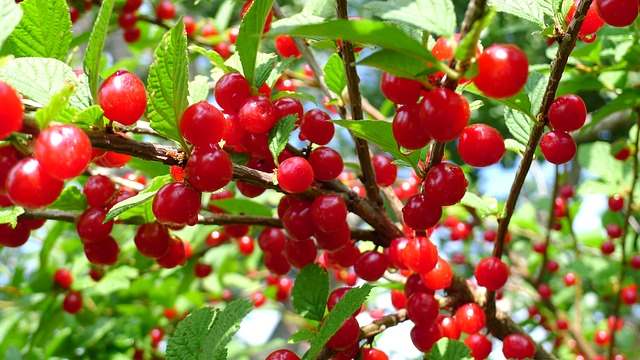
The edible Nanking red cherries grow on a deciduous ornamental shrub
The identification traits of the ornamental Nanking cherry shrub are its edible scarlet red berry-like drupes, masses of fragrant white showy flowers, and dark green leaves growing on reddish stems. The bright red fruits have a sweet, slightly tart taste and ripen to scarlet in summer.
Other common names for the Nanking cherry include downy cherry, mountain cherry, and Chinese bush cherry. Despite being called a cherry, this red fruit with a large stone in the center more resembles a plum. Each red-colored drupe measures between 0.2” to 0.47” (5 – 12 mm) in diameter.
Red Nanking cherry drupes grow on a deciduous shrub maturing at 10 ft. (3 m) tall. However, with care and pruning, the fast-growing shrub is ideal for foundation planting, growing along borders, or planting as a privacy screen or windbreak.
Apart from its decorative uses in a garden landscape, the abundant red berries are delicious and attract wildlife. In addition, the tangy-sweet red “berries” are popular for making jams, wine, juice, or pickling with vegetables.
Cornelian Cherry Dogwood (Cornus mas)
Dogwood is a large flowering shrub or small tree that has long green leaves, small yellow flowers, and red berry-like drupes. The little shiny red dogwood berries have the shape of coffee beans. When ripe, they taste like a cross between cranberries and sour cherries.
Dogwood trees and shrubs are native to countries in Southern Europe and Southwestern Asia. They grow to between 16 and 40 ft. (5 – 12 m) tall, leaves are oval or oblong and measure up to 4” (10 cm) long and 1.5” wide.
Related: Amazing Varieties of Sweet and Tart (Sour) Cherries (With Pictures)
Yew (Taxus)
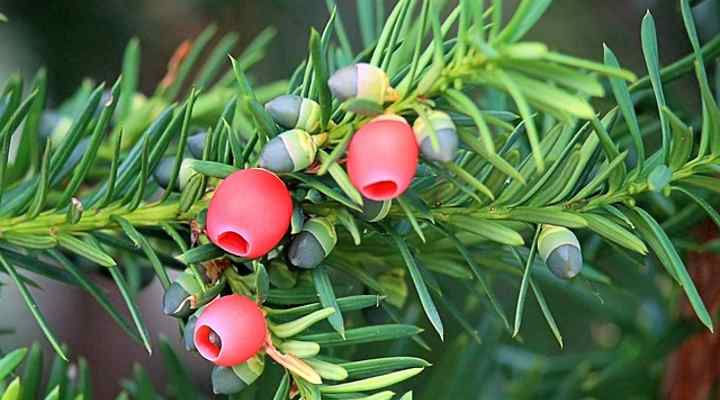
Yew leaves and mature and immature fruit
Yew (botanical name Taxus) is a genus of slow-growing coniferous evergreen trees and shrubs. Yews are identified by their thin, scaly brown bark, tiny single-seed cones, red fruits, and linear flat leaves. The English yew (Taxus baccata) is the most common species. But Irish yew, Western yew, and Japanese yew are also ornamental conifer trees.
An identifiable feature of yew shrubs and trees is their red berry-like fruits called arils. These cup-shaped fruits contain a single poisonous seed. The fleshy-red aril is the only part of the yew plant that is edible. Unlike most species of conifers with seed-bearing cones, yew fruit and seeds grow directly on the stems, not in cones.
Yews are cold-hardy evergreen plants that thrive in USDA zones 3 to 7. Yews can grow in temperatures as low as -13°F (-25°C); however, the shade-loving yew plants don’t perform well in prolonged hot temperatures. Ensure that the ground is well-draining and protect yew trees from heat, drought, and full sun for more than six hours a day.
Further reading: Yew Trees: Types, Berries, Leaves – Identification.
Buffalo Berry (Shepherdia)
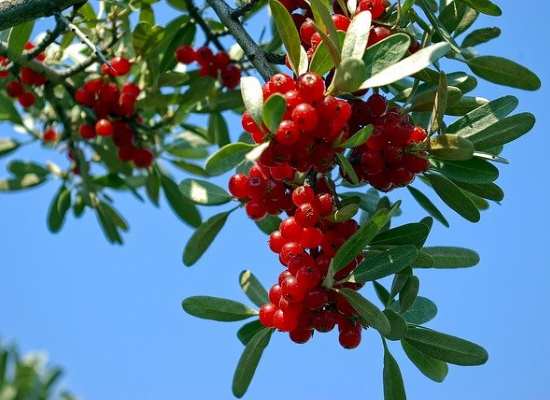
Buffaloberry (Shepherdia) shrub produces edible sour-tasting red berries
Buffalo berry is a dark red fruit with a rough texture and a sour taste. The clusters of red berries have identifiable tiny white dots on them. The red fruit grows abundantly on the buffaloberry plant, a large deciduous shrub that grows 8 – 10 ft. (2.4 – 3 m) tall.
The sour-tasting bright red berries are typically used in making jellies, jams, or pies.
Buffalo berry shrubs are identified by their attractive narrow, oblong leaves, thorny branches, and pea-sized, bright red berries. The green leaves contrasting with the red-colored fruit make the thicket-forming plant a beautiful background plant, security hedge, or specimen plant.
Another attractive bush with red berries is the silver buffaloberry (Shepherdia argentea). This cultivar has silvery-green leaves that grow up to 2” (5 cm) long. Each red berry on the bush contains a single seed, and the berries measure 0.25” (6 mm) in diameter.
European Spindle (Euonymus europaeus)
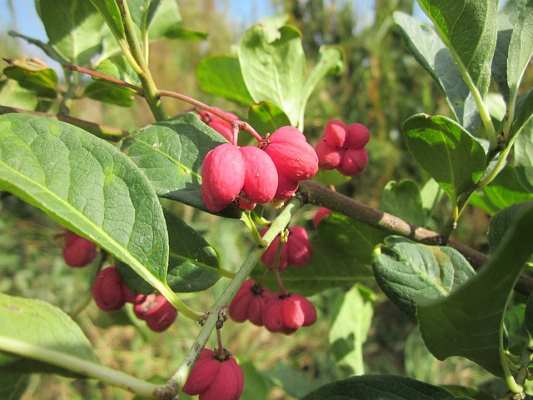
The unusually shaped red berries of spindle shrubs are toxic and should not be ingested
The European spindle (Euonymus europaeus) is a large shrub that can be identified by its pinkish-red berries in the fall and its lanceolate leaves with serrated margins. Each small reddish berry contains tiny seeds encased in an orange aril, similar to a pomegranate. The unusual inedible red berries have four lobes, giving them a bumpy appearance. They split open in the fall to reveal the orange seeds.
The European spindle shrub can be easily recognized by its lanceolate leaves with serrated margins, irregular crown, showy fall fruit, and stunning yellow fall colors. This attractive landscape shrub reaches an impressive height of 12 to 20 ft. (3.6 – 6 m) and can spread up to 16 ft. (4.9 m) wide.
Although they look attractive, the showy red berries are poisonous and should not be consumed. Despite producing poisonous red fruit, spindle shrubs are popular for foundation planting, using as a deciduous hedge, or planting as a specimen shrub.
Red Elderberry (Sambucus racemosa)
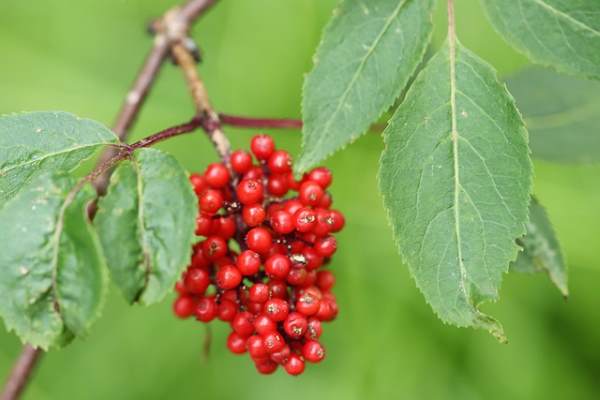
The small red elderberries should not be eaten raw and must be cooked first
The large red elderberry shrub is identified by its eye-catching clusters of bright red, round berries. These tiny red elderberry berries grow in dense clusters and add attractive bright red colors to the shrub in the summer and fall. The bunches of little red fruits follow clusters of lemon-scented white flowers.
Also called the red-berried elder, other species of the tree / shrub produce black or white small round berries. Although red elderberries are safe to eat after cooking, you should never eat them raw. Ingesting the tiny red berries can cause discomfort.
In the landscape, the red elderberry plant is a tall shrub growing 7 – 20 ft. (2 – 6 m) tall. The multi-stemmed treelike bush is identified by its pinnate-compound leaves containing five to seven leaflets. The clusters of flowers grow in a characteristic dome shape, followed by dark red elderberry fruits.
Strawberry Tree (Arbutus unedo)
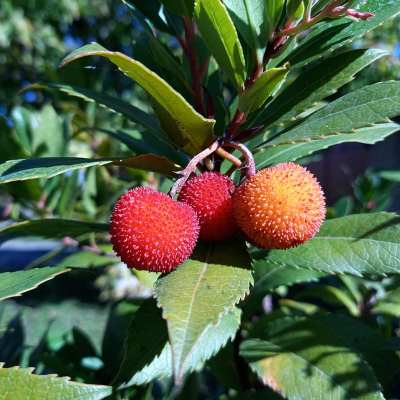
The evergreen strawberry tree has red spiky edible berries
Spiky red berries are an unusual identifying trait of the evergreen strawberry tree. The spherical red berries have a rough surface and have a pleasant, sweet taste. The berries range in size from 0.3” to 0.8” (7 – 20 mm) and are ripe for eating in the fall, just when the plant begins to blossom again.
Thriving in USDA zones 7 – 10, the strawberry tree is a large broadleaf shrub or a small tree that grows between 6 and 15 ft. (1.8 – 4.5 m). The ornamental shrub is identified by its unusual yellow and red fruit, fragrant bell-shaped white flowers, and peeling gray-brown bark. The glossy green leaves grow on reddish stems.
The unusual red berries from the strawberry tree have a subtle aroma like anise. Biting into the strawberry fruit reveals a sweet, tangy flavor reminiscent of mango, peach, and apricot. The berries emerge yellow and turn red as they ripen. However, the sweet red berries are usually made into jams, jellies, and sauces due to their gritty texture.
Red Berry Mistletoe (Viscum cruciatum)

Mistletoe plant produces poisonous red berries
Mistletoe is a plant producing poisonous red berries. This plant is neither a berry-producing shrub nor tree but is a type of parasitic plant that grows on trees and shrubs.
You can often spot red berry mistletoe growing high in the branches of tall trees where it can be mistaken for birds’ nests. This berry plant has small smooth oval green leaves and clusters of 2 to 6 berries.
Most people are familiar with the mistletoe species Viscum album (European mistletoe). The mistletoe species is a plant with small green leaves and white berries that are often associated with Christmas decorations.
Related: Delicious Types of Berries With Their Picture
Bloodberry (Rivina humilis)

The small evergreen bloodberry shrub produces clusters of poisonous red berries
Bloodberry is a small, shade-happy fast-growing evergreen shrub with clusters of bright scarlet berries, pale flowers, and large leathery leaves. In southern states, this woody perennial shrub blooms throughout the year. The drought-tolerant, low-maintenance berry-producing shrub grows 3 to 5 ft. (1 – 1.5 m) tall and 3 ft. (1 m) wide.
Also called pigeonberry or rouge plant, the eye-catching red berry clusters brighten shaded areas. Other landscaping ideas include planting the bushy plant as an accent piece, foundation planting, or fast-growing ground cover. However, it’s only cold-hardy in USDA zones 7 to 11. Hence, the shrub is suitable for growing in Texas, Florida, and other southern states.
It’s important to note that the blood-red berries are toxic and should not be eaten.
Dotted Wild Coffee (Psychotria punctata)
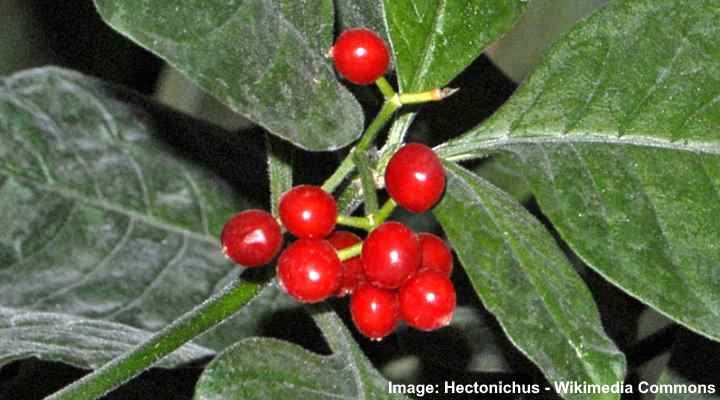
The tropical dotted wild coffee shrub has little shiny red berries
Dotted wild coffee is an evergreen shrub with bright red berries that thrives in tropical climates. Apart from the clusters of scarlet berries, identifying features of this bushy plant are its dark elliptic to ovate-elliptic green leaves. In the springtime, small white flowers appear, followed by bright red berries that ripen in late summer and early fall.
Although native to East Africa, the small evergreen shrub grows throughout southern Florida and the Florida Keys.
Wild Coffee (Psychotria nervosa)
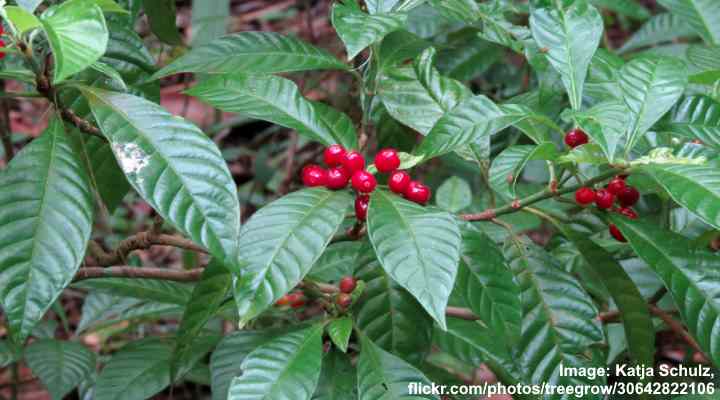
Wild coffee is a tropical shrub known for its glossy dark green evergreen leaves and brilliant small red berries
Wild coffee is known throughout the southern states for its bright, glossy red berries. Other identifying features of this ornamental native Florida shrub are its shiny lance-shaped leaves with a puckered appearance and clusters of small greenish-white flowers that blossom in spring.
Wild coffee shrubs grow 2 to 10 ft. (0.6 – 3 m) tall and up to 5 ft. (1.5 m) wide.
Wilde coffee is an attractive addition to any landscape or garden in South Florida or Texas as a specimen or foundation plant. The shape of the red berries is described as a “small, red ellipsoid fruit” resembling a coffee bean. Although you can roast the beans and brew a coffee substitute, there are reports that the drink causes headaches.
Wild coffee shrubs thrive in partial or full shade, and their shiny scarlet berries brighten up a shaded landscape. Suitable for growing in USDA zones 9 to 11.
Spotted Laurel (Aucuba japonica)
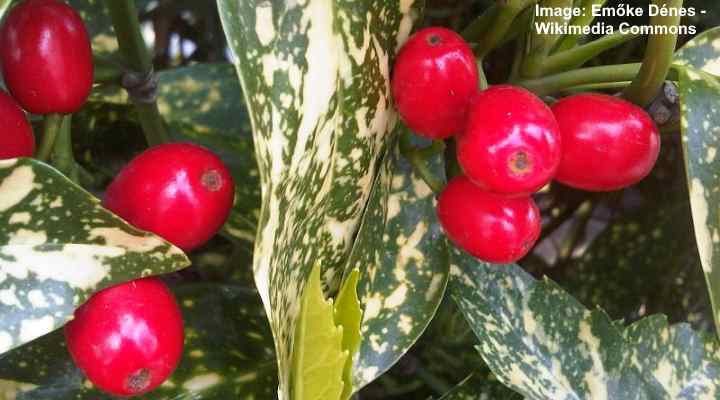
The spotted laurel is a great shrub for partial sun and shady areas with its decorative foliage and attractive red berries
Spotted laurel is an attractive ornamental shrub with deep red berries contrasting with its dense foliage of speckled green leaves. The spotted laurel shrub grows 3 to 16 ft. (1 – 5 m) tall, and has small purple flowers, long, lanceolate leaves 0.8” to 2” (2 – 5 cm) long, and red berry-like drupes.
Spotted laurel is a versatile landscaping shrub that thrives in various conditions. It performs well in dry shade and urban pollution and tolerates salty coastal winds. Uses for spotted laurel shrubs include shrub borders, an informal evergreen hedgerow, specimen plant, or foundation planting.
Spotted Laurel prefers partial shade and moist soil. It’s an ideal shrub to brighten a landscape because its red berries appear in fall and persist through winter until spring.
Chilean Guava Berry (Ugni molinae)
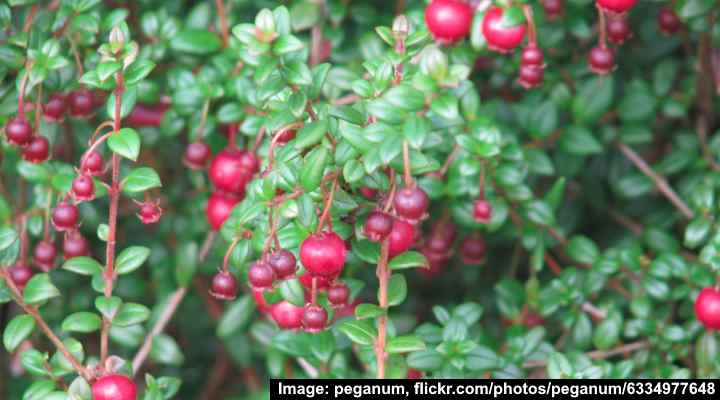
The Chilean guava shrub is identified by its small evergreen leaves and little edible dark red berries
Chilean guava shrubs produce sweet, dark red berries that dangle on long petioles from reddish stems. This bushy shrub has all-season interest. It has small oval to ovate evergreen leaves and clusters of fragrant pinkish-white bell shaped flowers followed by tasty red berries measuring 0.5” (1.3 cm) across.
The Chilean guava shrub grows 3 to 6 ft. (1 – 1.8 m) tall and wide. The showy red berries brighten summer and fall landscapes, making the small shrub perfect as a specimen plant, foundation planting, or shrub border.
This low-maintenance shrub prefers full sun or partial shade and thrives in well-drained, moist soil conditions. Suitable for growing in USDA zones 9 and 10.
Korean Barberry (Berberis koreana)

Korean barberry is semi-evergreen landscaping bush that provide year round interest with yellow flowers and red berries
Korean barberry is known in temperate climates for its showy clusters of egg-shaped bright red berries. This attractive ornamental shrub features green leaves that turn maroon and purple in the fall. Also, small yellow flowers bloom in eye-catching drooping clusters in springtime, followed by bright red berries which ripen from late summer through early fall.
Korean barberry is a multi-stemmed shrub with dense foliage growing in a rounded habit. The flowering shrub grows 4 to 6 ft. (1.2 – 1.8 m) tall and wide, making it an ideal specimen shrub for sunny small to medium-sized yards. Other landscaping uses for Korean barberry include a flowering hedge, informal screen, or foundation planting.
Japanese Skimmia (Skimmia japonica)
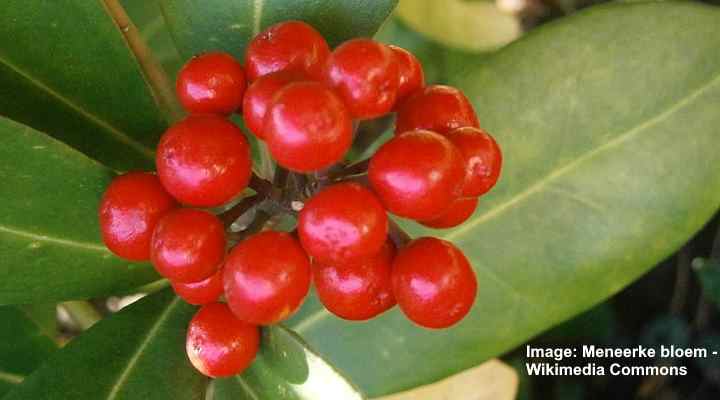
Japanese skimmia is a small flowering evergreen shrub that produces red glossy berries and is suitable for shaded areas
Shade-loving Japanese skimmia looks spectacular when its masses of shiny scarlet berries appear in the fall and persist through winter. The ornamental value of this evergreen shrub is enhanced by its clusters of star-shaped creamy white-pinkish flowers, leathery, lanceolate aromatic leaves, and round red berries.
Japanese skimmia is an excellent choice if you wish to plant a hedge, privacy barrier, shrub border, or understory shrub. Thriving in USDA zones 6 through 8, the shrub blooms and produces abundant red berries despite growing in the shade. The rounded ornamental shrub grows 3 to 4 ft. (1 – 1.2 m) tall and 4 to 5 ft. (1.2 – 1.5 m) wide.
Scarlet Firethorn Shrub (Pyracantha coccinea)
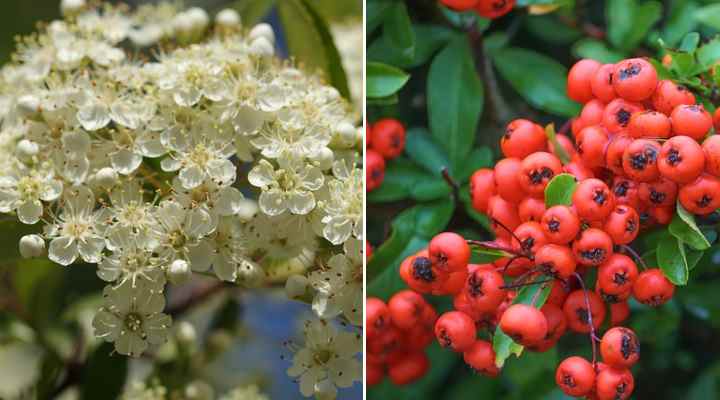
Scarlet firethorn shrub can be identified by its white flowers in late spring to early summer and red berry-like fruit that mature in late autumn
Scarlet firethorn shrub is a thorny evergreen shrub with abundant clusters of glossy red berries. Identifying features of the firethorn shrubs are their stiff, woody stems, masses of small white flowers, and a profusion of crimson berries that cover the shrub in the fall and winter.
Also called fire bush, or everlasting thorn, this spiny shrub grows 3 to 4 ft. (1 – 1.2 m) tall and up to 5 ft. (1.5 m) wide. The shrub’s dense growth and thorny branches make it ideal as an impenetrable hedge, privacy screen, wall-side border, or hedge plant to hide a fence.
With their evergreen foliage, showy flowers, and clusters of scarlet-colored berries, firethorn shrubs have all-season interest in USDA zones 6 through 9.
Magnolia Vine (Schisandra chinensis)
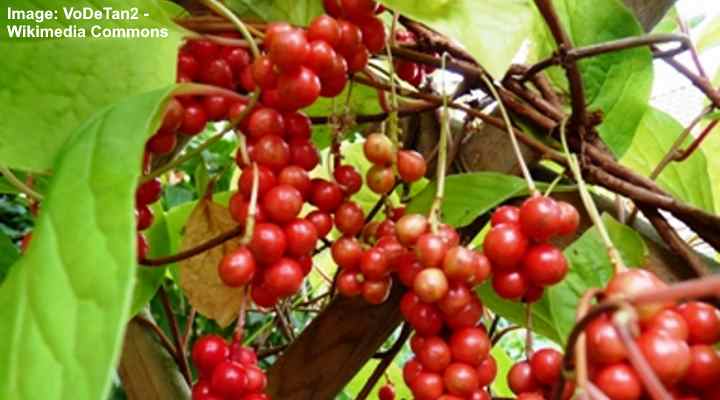
Magnolia vine is a large climbing shrub with clusters of red berries and aromatic foliage
The magnolia vine is a bushy vining plant that produces small round red berries in dense, grape-like bunches. The other identifying features of the magnolia vine are its lemon-scented aromatic leaves, creamy-white to reddish flowers, and thick, woody stems. The large berry-producing plant grows 26 to 30 ft. (8 – 9 m) tall.
Red magnolia berries grow in dense clusters, dangling from woody stems. The edible red berries have an unusual taste—a combination of five flavors, sweet, salty, spicy, bitter, and sour. For this reason, magnolia berries are also called five-flavor fruits
The red berries measure 0.20” to 0.40” (0.5 – 1 cm) in diameter. The crimson berries grow in bunches measuring 4” (10 cm) long. These bright red fruits contrast nicely with the fragrant oval leaves that are 2” to 4.3” (5 – 11 cm) long.
Sumac Shrubs (Rhus)
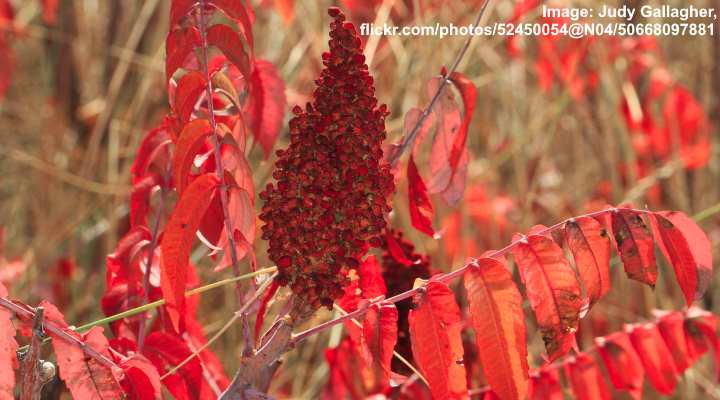
Smooth sumac (rhus glabra) fruit and autumn foliage
Several varieties of sumac plants are large, bushy shrubs with rust-red, reddish-pink, or flame-red berries that appear in the fall. An identifying feature of sumac shrubs is their fern-like foliage of pinnately compound leaves. In the fall, sumac shrub foliage turns showy shades of purple, burgundy, orange, or deep red.
An easily identifiable feature of sumac shrub berries is their fuzzy appearance. The berry-like red drupes grow in upright or arching dense clusters.
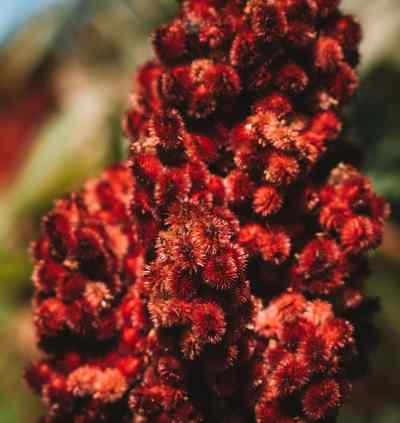
A close up picture of sumac fruit
Varieties of sumac shrubs with red berries include shining sumac (Rhus copallina), smooth sumac (Rhus glabra), lemonade berry (Rhus integrifolia), and staghorn sumac (Rhus typhina). The red berry clusters can be rounded or conical, depending on the cultivar.
Related reading: Varieties of sumac trees.
Agarita (Mahonia trifoliolata)

Agarita is a spiky plant with prickly leaves, yellow flowers and red berry-like fruit
If you want to plant a thorny bush with red berries, agarita is an excellent choice. Agarita is an evergreen shrub with a rounded habit, needle-sharp leaves, bright yellow, cup-shaped flowers, and bunches of edible red berries. Also called the Laredo Oregon grape shrub, the small suckering bushy plant grows 2 to 6 ft. (0.6 – 1.8 m) tall and wide.
The agarita shrub is tolerant of drought and dry landscapes. Suitable for desert landscapes, the plant is an ideal addition to yards in Texas, Arizona, southern California, and New Mexico. You can plant agarita as a foundation planting, border shrub, or to prevent soil erosion on slopes or banks.
Thimbleberry (Rubus parviflorus)
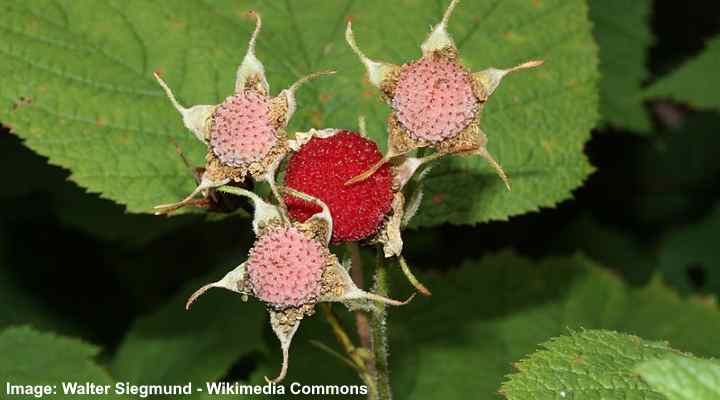
Thimbleberry shrub produces edible red berry-like fruits in mid to late summer
Thimbleberry is a multi-stemmed deciduous shrub with bright scarlet berries. The identifying features of thimbleberry shrubs are their large maple-like leaves with a velvety feel, showy clusters of fragrant white flowers, and tasty red fruits you can eat straight off the shrub. Thimbleberry shrubs grow 4 to 8 ft. (1.2 – 2.4 m) tall and wide.
Thimbleberry shrubs with their red raspberry-like fruits are native to North America. The hardy plants thrive in USDA zones 3 to 10 and perform best in full sun or partial shade. In addition to showy red berries, ornamental features of thimbleberry shrubs are their brilliant orange to deep red fall colors.
Proceed with Caution
If you are unsure about the species of plant that red berries are from, you should never eat them. Also, if you have houseplants that grow toxic red berries, you should keep them away from pets and children.
The Western Journal of Emergency Medicine warns about the dangers of certain popular holiday plants that have red berries. Very often, the poisonous substances in some types of berries affect children and pets more severely than adults. Some of the berries mentioned on this list are American and European mistletoe, English and American holly, and bittersweet. (2)
Learn How to Identify Trees With Red Berries.
Related articles:
- Different Kinds of Berries and Their Benefits
- Types of Fruit Trees with Pictures
- 18 Types of Bushes and Shrubs to Grow in Your Yard

